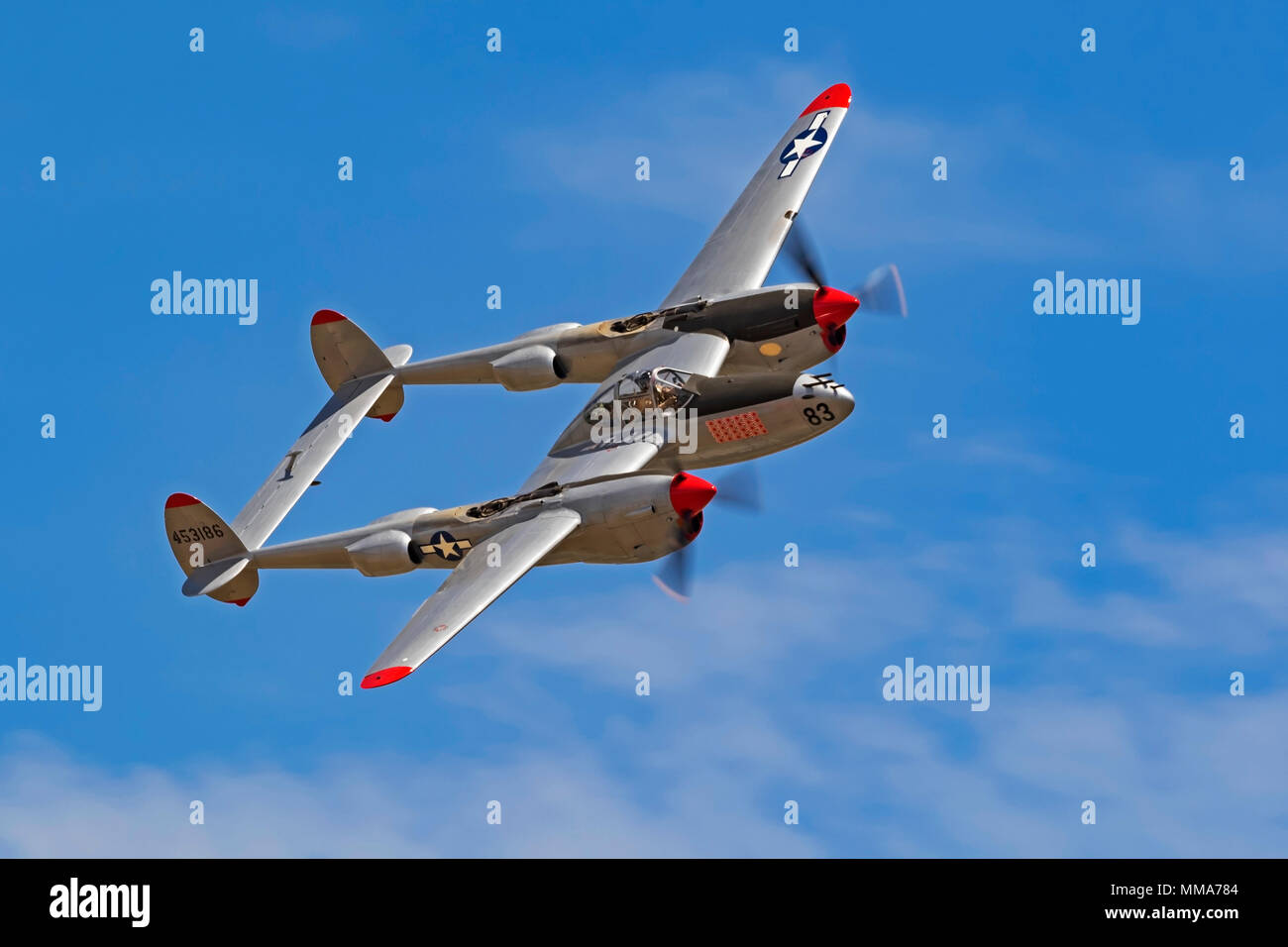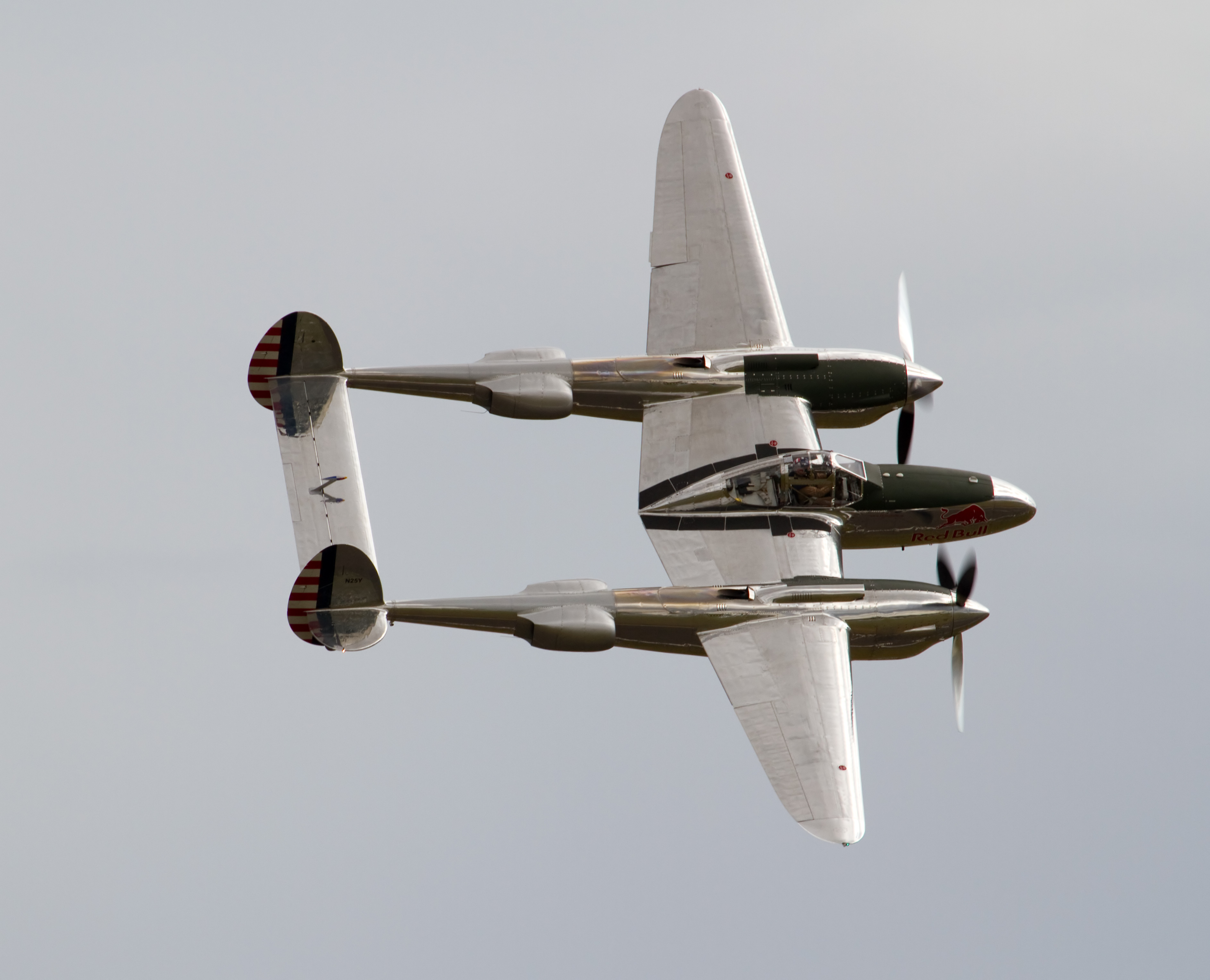Lockheed P38 Lightning - The Lockheed P-38 Lightning was an American single-seat, piston-engine fighter aircraft used during World War II. Designed by the Lockheed Corporation P-38 for the United States Air Force, the P-38 includes a split twin crown design with a central nacelle that houses the cockpit and weapons. Along with its use as a general-purpose fighter, the P-38 was used in a variety of air combat roles, including an excellent fighter, a night fighter, and a long-range escort fighter equipped with tanks.
The P-38 was also used as a bomber, directing streams of medium and heavy bombers, or other P-38s equipped with bombers, to targets.
Lockheed P38 Lightning

Used in the aerial reconnaissance role, the P-38 accounted for 90 percent of the aerial footage captured in Europe.
Lockheed P 38 Lightning Hd Wallpapers And Backgrounds
The P-38 was used with great success in the Pacific Theater of Operations and the China-Burma-India Theater of Operations as the aircraft of America's greatest aces, Richard Bong (40 victories), Thomas McGuire (38 victories), and Charles H. MacDonald (27 victory). In the Southwest Pacific theater, the P-38 was the primary long-range fighter of the United States Air Force until the introduction of many P-51D Mustangs in the war.
Unusually for an early production fighter, both engines were supplemented by turbosuperchargers. This gave the P-38 a high altitude performance, making it one of the earliest fighters capable of high altitude performance.
The Lightning is forgiving in flight and can make mistakes in many ways, but the amount of roll in early versions is low compared to other current fighters; This was addressed in later variants with the introduction of hydraulically reinforced ailerons.
The P-38 was the only American fighter in large-scale production throughout the American involvement in the war, from the Attack on Pearl Harbor to the victory over Japan.
P 38 Lightning
The Lockheed Company built the P-38 in response to a February 1937 specification by the United States Army Air Corps (USAAC). Proposal Circular X-608 is a series of aircraft mission plans written by First Lieutenants Benjamin S. Kelsey and Gordon P. Saville for a high-altitude "interceptor" with "an interception and countermeasures mission against aircraft". high altitude."
Forty years later, Kelsey explained that he and Saville drew up instructions using the term "interceptor" as a way to circumvent the Air Corps' difficult search for unmanned aircraft to carry more than 500 lb (230 kg) of weapons including ammunition, and to exceed the USAAC limit for an airplane seat for one gin. Kelsey is looking for a minimum of 1,000 lb (450 kg) of armor.
Kelsey and Saville aim to find a more capable fighter, better at dogfighting and at high altitudes. Specifications require a maximum speed of at least 360 mph (580 km / h) at altitude, and a climb of 20,000 feet (6,100 m) in six minutes,

The toughest series in the USAAC came first. The unbuilt Vultee XP1015 was designed for the same needs, but wasn't advanced enough to merit further investigation. A similar proposal for a single-engine fighter was submitted at the same time, Circular Proposal X-609, in response to which the Bell P-39 Airacobra was developed.
P 38 Lightning 1/72 From Hobby2000| Sklep Modelarski Arma Hobby
Lockheed created a secret task force to complete the project separate from the main factory; This approach was later called Skunk Works.
The Lockheed design team, under the leadership of Hall Hibbard and Clarce "Kelly" Johnson, considered one of the twin-engined configurations, including two engines in the central fuselage and a checkerboard.
The evtual configuration is rare in the context of modern aircraft production, and the Dutch Fokker GI heavy fighter, and then the Northrop P-61 Black Widow night fighter and the Swedish SAAB 21 have a similar arrangement. The Lockheed team chose twin booms to accommodate the assembly, engines, and turbosuperchargers, along with a central nacelle for the pilot and armament. The XP-38 nacelle mockup was designed to mount two .50-caliber (12.7 mm) M2 Browning machine guns with 200 rounds per gun (rpg), two .30-caliber (7.62 mm) Brownings with 500 rpg, and US Army Ordnance. Departmt model T1 23 mm (.90 in) autocannon with field magazine as a replacement for the non-existent 25 mm Hotchkiss aircraft autocannon listed by Kelsey and Saville.
In the YP-38 prototypes, the Army Air Forces Departmt T9 37 mm (1.46 in) autocannon (later designated as M4 in production) with 15 rounds replaced the 23 mm T1.
P 38 Lightning
The 15 rounds were in three five-piece clips, a complaint according to Kelsey, and the T9/M4 did not perform well in flight. Additional weapons testing from March to June 1941 resulted in the P-38E being armed with four M2 Browning machine guns, and one Hispano 20 mm (.79 in) autocannon with 150 rounds.
Assembling all weapons in the nose is unusual in US aircraft, which often use wing-mounted weapons with trajectories set to intersect at one or more points in a convergent area. Gun mounts don't suffer in effectiveness as they are limited by chain links, meaning good drivers can shoot more. The Lightning can effectively engage targets at any distance up to 1,000 yd (910 m), while other firepower wings are optimized for certain ranges.
The rate of fire is about 650 rounds per minute for a cannon round 20 × 110 mm (shell 130 grams) at a speed of 2,850 feet / s (870 m / s), and for a machine gun .50- caliber (43). -gram rounds), approximately 850 rpm at 2,900 ft/s (880 m/s) speed. The combined rate of fire is more than 4,000 rpm and about every sixth projectile is a 20 mm shell.

The time of fire for the 20 mm cannon is about 14 seconds, while the .50 caliber machine gun works for 35 seconds if each magazine is loaded with 500 rounds, or for 21 seconds. long distance flight.
Lockheed P 38 Lightning Fighter
The Lockheed design uses a bicycle frame and bubble frame, and has two 1,000 hp (750 kW) turbosupercharged 12-cylinder Allison V-1710 engines equipped with counter-rotating propellers to eliminate the effect of engine torque, and rear-position turbochargers they . the gins, the outer part of the unit extends over the dorsal surface of the booms.
The mutation is achieved using the genes "cut"; The crankshafts of the engines rotate in opposite directions, a relatively easy task for the V-1710 module-built aircraft engine.
The P-38 was the first American fighter to use stainless steel and a smooth, riveted, but-jointed aluminum skin.
Lockheed won the competition on June 23, 1937 with its Model 22 and was contracted to build the XP-38.
P 38 Lightning\
Construction began in July 1938 on a former bourbon distillery purchased by Lockheed for an expansion building. Johnson later identified this secure and remote location as the first of five Lockheed Skunk Works locations.
Kelsey th requested to run to Wright Field on February 11, 1939 to transfer the aircraft to further testing. Geral Hry "Hap" Arnold, head of the USAAC, approved the test case and agreed to cross the country to New York. The flight set a speed record when it flew from California to New York in 7 hours and two minutes, excluding two stops.
Kelsey flies in different directions, working on the gins gtly, ev throttling back while the desct eliminates the impact speed advantage. Bundled up against the cold, Arnold congratulated Kelsey at Wright Field during her last refueling stop, and said, "don't leave the horse" on the next leg.

After climbing out of Wright Field and reaching altitude, Kelsey pushed the XP-38 to 420 miles per hour (680 km/h).
Lockheed P 38j 10 Lo Lightning
Near his destination, Kelsey was ordered from Mitchel Field Tower (Hempstead, New York) in a slow landing pattern behind other aircraft. Carburetor icing caused him to ride short on the Mitchel track, and he crashed. However, according to records, the Air Corps ordered 13 YP-38s on April 27, 1939 for US$134,284 each.
(The "Y" in "YP" is the USAAC name for the test program, meaning the early part of the aircraft, while the "X" in "XP" is for experimental.) Lockheed's chief pilot, Tony LeVier, characterized in anger Acidt as inappropriate advertising,
But according to Kelsey, the loss of the model, which does not affect the program, made the process by cutting short the first test series. The success of the aircraft design contributed to Kelsey's promotion to captain in May 1939.
Mechanized P-38 assembly line in Burbank, California: The aircraft starts at the rear of the building on the right side (without wings, hence the narrow section). When they reach d in this line, they change to line cter, take wing, and move to this line. When they reach d, they transfer to the lane on the left, and go up to d on the lane.
P 38 Lockheed Lightning Landing Gear Warning Indicator
Production of the YP-38s fell behind schedule, at least in part due to changes made to meet mass production demands, making them different in construction from the prototype. Another important thing is Sudd's need for the expansion of Lockheed's headquarters in Burbank, taking it from a special public company involved in a small order of a large government against the contractor Vturas, Harpoons, Lodestars, and Hudson.
P38 lightning for sale, lightning p38 recumbent for sale, lockheed p38, lockheed martin f 35 lightning, p38 lockheed lightning, p38 lightning, lockheed martin f 35 lightning 2, p38 lightning model, lightning p38 recumbent, p38 lightning model kit, lockheed p 38j lightning, rc p38 lightning
0 Comments